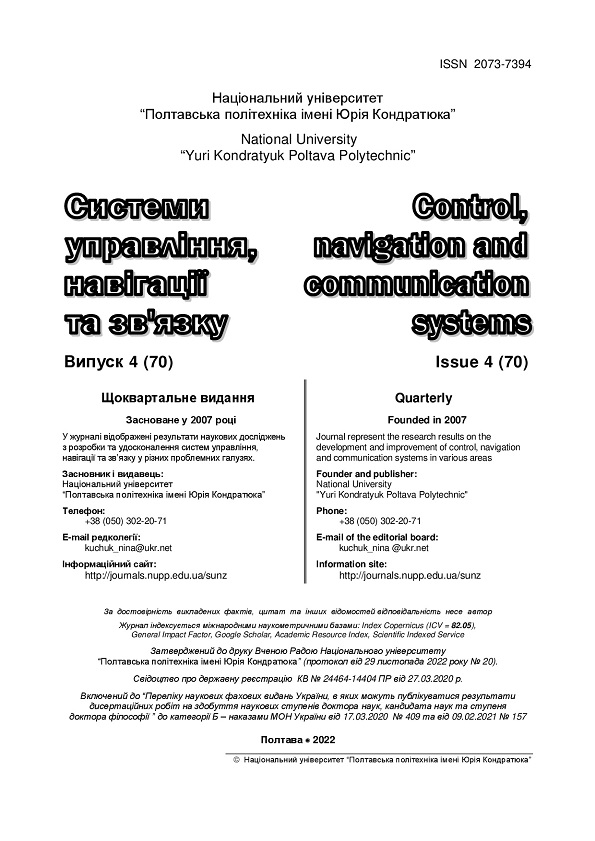MEANS OF INCREASING THE EFFICIENCY OF LIQUID MATERIALS FOR SHIELDING ELECTROMAGNETIC FIELDS OF A WIDE FREQUENCY RANGE
DOI:
https://doi.org/10.26906/SUNZ.2022.4.138Keywords:
composite liquid materials, shielding, electromagnetic fieldsAbstract
Regulatory and legal European and national requirements form a number of issues related to the simultaneous provision of electromagnetic safety of people in industrial and domestic conditions, as well as electromagnetic compatibility of electrical and electronic equipment. A study was conducted on the development and implementation of effective protective materials against the influence of electromagnetic fields of a wide frequency range. A methodological approach is proposed for the production of liquid compositions for shielding electromagnetic fields of industrial frequency, very high and ultrahigh frequencies. A water-dispersion paint was chosen for conducting research with a matrix as a filler carrier. Iron ore concentrate with a predominant (up to 75–80%) content of magnetite and foundry flake graphite were used as fillers. Determination of the protective properties of the experimental samples was carried out by establishing the dependence of the shielding coefficients of the industrial frequency electric field, industrial frequency magnetic field and ultra-high frequency electromagnetic field on the weight content of the filler. Measurements of electric and magnetic field strengths were performed with a calibrated PZ-50 device. The energy flow density of the ultra-high frequency electromagnetic field was measured using a calibrated PZ-31 device. Measurement of shielding coefficients was carried out using closed screens, inside which a measuring antenna was placed through a technological hole. Finding acceptable ratios of electrophysical and magnetic properties of the components of the composite determines the need for a preliminary calculated assessment of the properties to obtain the required shielding coefficients. The most suitable for magnetite particles in iron ore concentrate are Lorentz and Maxwell-Garnett relations. For graphite, it is advisable to use Odelevsky's formula. It is shown that these liquid-based composites have a number of advantages due to their relative ease of manufacture and convenience of application on the surface of large areas and complex configurations, as well as the adjustability of absorption and reflection coefficients due to the physicochemical composition and manufacturing technologies. The use of composite liquid materials allows solving the problems of ensuring electromagnetic safety, electromagnetic compatibility and is expedient for technical and economic reasons.Downloads
References
Directive 2013/35/EU of the European Parliament and of the Council of 26 June 2013 on the minimum health and safety requirements regarding the exposure of workers to the risks arising from physical agents. Official Journal of the European Union, 2013. URL: http://data.europa.eu/eli/dir/2013/35/oj (дата звернення: 30.08.2019).
ETSI EN 300 220-2 V2.4.1 (2012-01). Electromagnetic compatibility and Radio spectrum Matters (ERM); Short Range Devices (SRD); Radio equipment to be used in the 25 MHz to 1 000 MHz frequency range with power levels ranging up to 500 mW; Part 2: Harmonized EN covering essential requirements under article 3.2 of the R&TTE. Directive. European Telecommunications Standards Institute. 2012. 20 р. URL: https://www.etsi.org/deliver/etsi_en/300200_300299/30022002/02.04.01_40/en_30022002v020401o.pdf (дата звернення: 30.08.2019).
Patil, N., Velhal, N. B., Pawar, R., Puri, V. (2015). Electric, magnetic and high frequency properties of screen printed ferriteferroelectric composite thick films on alumina substrate. Microelectronics International, 32 (1), 25–31. doi: https://doi.org/10.1108/mi-12-2013-0080
Mondal, S., Ganguly, S., Das, P., Khastgir, D., Das, N. C. (2017). Low percolation threshold and electromagnetic shielding effectiveness of nano-structured carbon based ethylene methyl acrylate nanocomposites. Composites Part B: Engi-neering, 119, 41–56. doi: https://doi.org/10.1016/j.compositesb.2017.03.022
Беляев, А. А., Беспалова, Е. Е., Лепешкин, В. В. (2015). Радиопо-глощающие материалы на основе отделочных строительных материалов для защиты от СВЧ излучения базовых станций сотовой связи. Труды ВИАМ, 6, 80–88.
Barsukov, V., Senyk, I., Kryukova, O., Butenko, O. (2018). Composite Carbon-Polymer Materials for Electromagnetic Radiation Shielding. Materials Today: Proceedings, 5 (8), 15909–15914. doi: https://doi.org/10.1016/j.matpr.2018.06.063
Senyk, I. V., Kuryptya, Y. A., Barsukov, V. Z., Butenko, O. O., Khomenko, V. G. (2020). Development and Application of Thin Wide-Band Screen-ing Composite Materials. Physics and Chemistry of Solid State, 21 (4), 771–778. doi: https://doi.org/10.15330/pcss.21.4.771-778
Guzii, S., Kryvenko, P., Guzii, O., Yushkevich, S. (2019). Determining the effect of the composition of an aluminosilicate binder on the rheotechnological properties of adhesives for wood. Eastern-European Journal of Enterprise Technolo-gies, 6 (6 (102)), 30–38. doi: https://doi.org/10.15587/1729-4061.2019.185728
Glyva, V., Bakharev, V., Kasatkina, N., Levchenko, O., Levchenko, L., Burdeina, N., Guzii, S., Panova, O., Tykhenko, O., & Biruk, Y. (2021). Design of liquid composite materials for shielding electromagnetic fields. Eastern-European Journal of Enterprise Technologies, 3(6 (111), 25–31. https://doi.org/10.15587/1729-4061.2021.231479




